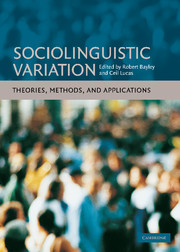Book contents
- Frontmatter
- Contents
- 1 List of figures
- 2 List of tables
- Acknowledgments
- Notes on editors and contributors
- Introduction
- Part 1 THEORIES
- Part 2 METHODS
- 9 Sociolinguistic fieldwork
- 10 Quantitative analysis
- 11 Sociophonetics
- Part 3 APPLICATIONS
- Afterword: Walt Wolfram and the study of sociolinguistic variation
- References
- Index
9 - Sociolinguistic fieldwork
Published online by Cambridge University Press: 16 February 2010
- Frontmatter
- Contents
- 1 List of figures
- 2 List of tables
- Acknowledgments
- Notes on editors and contributors
- Introduction
- Part 1 THEORIES
- Part 2 METHODS
- 9 Sociolinguistic fieldwork
- 10 Quantitative analysis
- 11 Sociophonetics
- Part 3 APPLICATIONS
- Afterword: Walt Wolfram and the study of sociolinguistic variation
- References
- Index
Summary
Introduction
Conducting fieldwork to obtain data for sociolinguistic study is at the same time one of the most challenging and most rewarding aspects of sociolinguistic investigation. Among the challenges that immediately come to mind are: (1) How do I decide who to get data from? (2) How do I get people to talk to me and let me record them, and can I get them to talk in a fairly relaxed way? (3) How do I explain to people why I'm recording them, and how much detail should I go into? (4) How do I make good-quality recordings, especially out in the “field” vs. in a quiet laboratory? and (5) How involved should I get with my research participants and in what ways? This last question connects directly to what is perhaps the biggest reward associated with gathering linguistic data from “real” people out in the “real” world – getting the chance to meet, talk with, befriend, and perhaps help all sorts of interesting people who may have just as much to teach the researcher about different ways of looking at life as about different ways of speaking.
In the sections that follow, the above questions are addressed, along with others that arise in the course of designing and conducting field research for sociolinguistics. Though researchers may have initially believed (or hoped) that it was possible to develop a set of universal guidelines for conducting sociolinguistic fieldwork, experience has demonstrated that there is no one “right” answer to any of the questions above.
- Type
- Chapter
- Information
- Sociolinguistic VariationTheories, Methods, and Applications, pp. 165 - 189Publisher: Cambridge University PressPrint publication year: 2007
- 15
- Cited by

